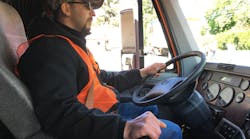Autonomous technologies and active safety systems can help attract a new generation of workers into trucking, industry officials told a House subcommittee.
“Automation can make the driving job better,” said Greer Woodruff, senior vice president of safety, security, and driver personnel at J.B. Hunt Transport Services. “It can be a more fulfilling type of work.”
Woodruff was one of four invited guests for a roundtable on “Emerging Technologies in the Trucking Industry” hosted by the House subcommittee on Highways and Transit.
Woodruff added younger workers enjoy working with emerging technologies, which are making the job of driving more appealing.
Similarly, Susan Alt, senior vice president of public affairs for Volvo Group North America, told the subcommittee there is a shortage of truck drivers because it is a “tough job.”
“We want newer, younger drivers,” Alt said. “Part of automation is just that – to lure more drivers in.”
However, Larry Willis, president of Transportation Trades Department, said the driver shortage was mainly due to wages and benefits not being high enough. He also expressed “serious concerns” about the impact automation will have on employment within the truck and bus sector in the coming years.
Willis said the “economy is not prepared for the job dislocation and downward pressure on wages” that will result. He called on lawmakers to react proactively to ensure the labor and safety policies keep pace with technology.
Overall, very little new ground was discussed during the 90-minute roundtable, but it did give trucking officials another opportunity to promote its investment and commitment to safety.
In his opening remarks, Woodruff noted his company was an early adopter of numerous technologies. “The trucking industry spends over $9 billion annually on safety including technology enhancements, to help ensure that drivers and passengers of all vehicles make it safely to their destination,” he said.
A common concern voiced by lawmakers was what steps they can take to help with job training as new technologies takes hold.
Woodruff said programs could be modeled after current steps being taken to get more military veterans into the industry.
TTD’s Willis, who suggested millions of positions are at stake, urged lawmakers “to think strategically about training for specific jobs in this economy.”
Woodruff downplayed concerns of job losses, even as he outlined a future scenario where driverless trucks could travel long stretches of open highways. If this happened, professional drivers would be strategically staged in locations to finish deliveries through more congested areas.
He also cautioned lawmakers from excluding trucking from autonomous legislation under development in Congress.
Jane Terry, senior director of government affairs for the National Safety Council, said she agreed trucking should be included in an autonomous regulatory framework.
She also backed efforts to promote active safety systems, saying the United States must “look beyond behavioral changes” to reduce highway accidents and fatalities.




